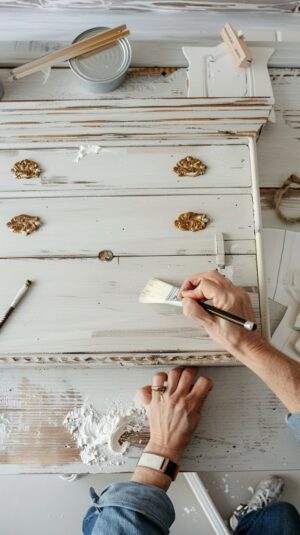Have you ever looked at a plain old piece of furniture in your home and thought, “Hmm, could I turn this into a vintage masterpiece?

Well, guess what? You totally can, and I’m here to spill some secrets on painting vintage furniture.
We’re not talking about just slapping on some paint and calling it a day.
Achieving that beautiful distressed look on furniture requires a little bit of technique and a whole lot of elbow grease. But trust me, the end result is so worth it.
Picture turning that boring old dresser or chair into something that tells a story, something with character and charm that feels like it’s been a part of your home forever.
So, let’s get into how you can create that vintage vibe step by step.
Materials and Tools: Getting Started
Gathering your supplies is the crucial first step in your vintage furniture transformation.
You’ll need to choose the right materials and tools to achieve the desired distressed look. Think about the type of paint that you will use carefully.
Chalk paint is popular for its matte finish and excellent adhesion properties, making it perfect for distressed furniture. Personally it is my favorite.
However, milk paint and acrylic paint are also great options, each has its own unique characteristics.
When you are selecting paint, keep in mind the color palette you want to work with and how it will enhance and show off your existing decor in your home.
Experimenting with different colors and finishes can help you achieve those stunning results. Also, don’t forget about primer, it provides a solid foundation for your paint and helps in making sure your results are smooth with a long-lasting finish.
In terms of tools, you’ll need a variety of brushes, sponges, and sandpaper to for different textures and effects. Consider investing in quality brushes designed specifically for furniture painting. They can and will make the process much easier and so much more enjoyable.
And remember, safety first. I sound like a nerd but really, safety should always be first. Be sure to wear gloves and a mask when sanding or working with certain finishes to protect yourself from harmful particles and fumes.
Just do what my favorite little puppy does and follow his lead. 🙂 Hey, anyone have a catchy name for this little guy, let me know in my comments below, I use him all the time to remind about safety, he is so cute. Since he is here to stay to help remind people, I figured I should give him a name. 🙂

Ok, now back to gathering all your supplies, it’s time to prepare your workspace now. Find a well-ventilated area where you can spread out your materials and work comfortably.
Lay down a drop cloth or old sheet to protect your floors and surfaces from paint spills and splatters. Don’t think it will not happen, because believe me when I say it WILL happen. haha.
By having everything organized and within reach, it will make the process easier and more efficient.
Step-by-Step Guide to Distressing Furniture
Now that you’ve gathered your supplies and prepared your workspace, it’s time to jump into the fun part, distressing your furniture!
Start by preparing the surface of your piece with a good cleaning to remove any dirt, grease, or old finishes. This step is absolutely necessary for making sure that your paint adheres properly and achieves the desired distressed effect.
Once your furniture is clean and dry, apply your base coat of paint.
Whether you choose a single color or multiple colors for a layered effect, be sure to allow each coat to dry completely before moving on to the next.
Let me say that one more time. let it DRY COMPLETELY. 🙂
Patience is key here, rushing the drying process can and will lead to uneven results and frustration down the line. I learned the hard way since I can be very impatient and it was annoying that It came out with uneven results. Oh boy was it not fun at all to restart.
When it comes to sanding, less is often more. Use fine-grit sandpaper to gently distress the edges and corners of your furniture, mimicking the natural wear and tear that occurs over time.
Take inspiration from authentic vintage pieces and pay attention to where wear would naturally occur. This attention to detail will help you achieve a more realistic distressed look.
Layering a few more coats of paint is where you can really get creative and add depth to your piece. Experiment with different colors and techniques, such as dry brushing or stenciling, to create unique effects.
Remember to let your imagination run wild and don’t be afraid to make mistakes sometimes the most beautiful results come from happy accidents! 🙂 This is true, I wouldn’t say it if I didn’t believe it and I truly believe it. So do not be afraid if it is a minor mishap.
Finally, complete your hard work with a clear topcoat to protect it from daily wear and tear. Choose a finish that enhances and shows off the overall look you’re going for.
Matte, satin, or glossy, choose one and apply it evenly so it lasts for years to come. I like Matte finish for the vintage distressed look, it makes the wear and tear look a bit more aged showing a true vintage look. My opinion atleast. 🙂
Creative Touches: Adding Character
Now that you’ve mastered the basics of distressing furniture, it’s time to add some special touches that will truly make your piece stand out.
Try applying a thin layer of wax or glaze to deepen crevices that will add dimension to your furniture. Dark wax can create a rich, aged look, while lighter wax can highlight details and add a light sheen to it.
Experiment with different techniques, such as dry brushing or stenciling, it will add texture and interest to your piece.
Here are the basic steps on drybrushing:
1. Typically, you’ll use a lighter color as the base coat and a darker color for dry brushing.
2. Dip the tip of a clean, dry paintbrush into the darker paint color. Then, lightly dab the brush onto a paper towel or piece of cardboard to remove excess paint. You want the brush to be almost dry, with just a small amount of paint remaining on the bristles.
3. Lightly drag it over the surface of the furniture in the direction of the wood grain. Use long, sweeping strokes to create a subtle, distressed effect. Focus on areas where natural wear and tear would occur, such as edges, corners, and raised details.
4. Gradually build up layers of dry brushing until you achieve the desired level of distressing. Start with a light touch and add more paint as needed to intensify the effect. Take breaks to step back and assess your progress, adjusting as necessary for the desired look.
5. To create a seamless transition between the base coat and the dry brushing, lightly feather the edges of the dry brushed areas with a clean, dry brush. This will help blend the colors together and create a more natural, aged appearance.
Optional: If desired, you can further distress the furniture by lightly sanding areas where wear would naturally occur. Use fine grit sandpaper and sand in the direction of the wood grain to avoid damaging the surface.
Alright lets move on to the next technique, stenciling.
Stenciling lets you add intricate patterns and designs, giving your furniture a one of a kind look.
The basic steps for stenciling:
1. First you will need to select a stencil design that complements the style and theme of your furniture. You can find a ton of stencil designs at craft stores or create your own using stencil blanks and a craft knife.
2. Position your stencil on the surface of your furniture and secure it in place with painter’s tape or stencil adhesive. Make sure the stencil is flat against the surface to prevent paint from bleeding underneath.
3. Pour a small amount of paint onto a palette or paper plate. Use acrylic craft paint or stencil paint for best results. You can choose a single color or multiple colors to create a layered effect.
4. Dip a stencil brush or foam dabber into the paint, then blot off any excess on a paper towel. Working in a circular motion, gently dab the paint onto the stencil openings. Be careful not to apply too much paint at once, as this can cause bleeding and smudging.
5. Once you’ve filled in all the stencil openings, carefully remove the stencil from the furniture while the paint is still wet. Peel it away slowly to avoid smudging the design. ( be very careful here because it is super easy to accidentally smudge).
6. Let the paint dry completely before moving on. This may take anywhere from a few minutes to a few hours, depending on the type of paint and the thickness of the application.
Optional: If you’d like, you can add more layers of stenciling using different colors or designs. Just be sure to allow EACH layer to dry completely before applying the next one.
Awesome huh? Let’s move on to Crackling…..
Crackle paint finish gives a true vintage look. This technique involves applying a crackle medium between two layers of paint, causing the top layer to crack and reveal glimpses of the base layer underneath. The result is a beautifully aged finish that adds character and charm to your furniture.
{Fun Fact: Anyone who likes to paint their nails? Crackle nail polish is sooo cool! It literally does the same exact thing. Imagine all the awesome vibrant colors you could use! LOVE IT!}
Alright back on track…..hehe…
How easy was all of that? I enjoy creating the wear and tear where I think it would look best. It is truly a fun project. I am always looking for one of a kind pieces at thrift stores to distress. SECRET: THRIFT STORES ARE WHERE IT’S AT FOR SCORING UNIQUE PIECES OF FURNITURE TO DISTRESS. 🙂
Maintaining Your Masterpiece
I bet you are proud you’ve successfully transformed your furniture into a stunning vintage masterpiece!
It’s important to take care of your hard work to make sure it looks its best for years to come. Choose a protective finish, such as wax or polyurethane, to seal and protect your furniture from everyday wear and tear.
In the event that your furniture gets scratched or damaged, don’t panic! Touch-ups are easy. Simply sand the affected area lightly, apply a small amount of paint, and blend it in with the surrounding area. With a little bit of effort, your furniture will look as good as new. Just be sure to LIGHTLY sand.
Continue to experiment with different colors, techniques, and styles to create unique and personalized pieces that reflect you and your style. The possibilities are endless literally, so don’t be afraid to get creative and have fun with it! I have sold a few pieces that I created, they were so unique and had so much character that nobody else could create but me, and you could not find in a store. You could do the same!
Don’t be afraid to think outside the box and experiment with different materials, colors, and techniques. Vintage furniture distressing is all about creativity and self-expression, so let your imagination run wild and have fun with it!
The best part? You really cannot go wrong.
Following these easy steps and tips and you’ll be well on your way to accomplishing the vintage look you envisioned.
Do not hesitate to reach out and comment below if you have any questions, or you want to show off your beatiful vintage masterpiece! I know everyone here at Home Revitalize DIY would love to see before and afters, as well as I would! So show us what you’ve got, go from drab to completely FAB!





